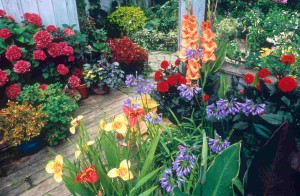Growing plants in containers can be the perfect solution for gardeners with limited space, and on Long Island, where we can have HOT summers, but super cold winters, it can even allow you to enjoy the beauty of tropical plants year round.
Type of container
Most nurseries offer a huge selection of terracotta, ceramic and plastic pots, but container gardening also offers the perfect opportunity to recycle something from the garage or basement. Watering cans, spatterware bowls, buckets, kitchen canisters, vintage cowboy boots, tires and even an old footed bathtub can all be used as planters.
You’ll want to consider how much weather the pot can handle; an old can that is prone to rust wouldn’t be appropriate in a rainy climate, for instance. Also, consider the size of plantings you’ll be adding; If you are going to grow vegetables, for example, the pot will need to be large enough to hold plenty of water and allow roots to develop.
“Beware of decorative planters that lack drainage holes,” says John Pohly, Colorado State University Extension Horticulturist. “This creates water-logged soil and rotting roots. Research shows that the old practice of placing a layer of gravel in the bottom of the container, to give some room for water to accumulate without saturating the soil, doesn’t really work. If you want to use a decorative planter that doesn’t have a drain hole, put your plants in a regular flower pot and place that inside the decorative container.”
Depending on what material the container is made of, you may also be able to drill or punch holes in the bottom of it. You can also recycle a used plastic milk jug or soda bottle as a pot liner; just punch drainage holes in the bottom with a nail.
Growing medium
You can buy special organic container mix at many garden centers, or you can make your own by amending dirt from your garden for container gardening; simply mix together one part garden soil, one part compost and one part sand. You may also want to add some peat moss, which will help the mixture hold water. To improve drainage you can also add organic perlite, which lightens the soil mixture and has a neutral pH.
What to plant
People grow nearly every plant under the sun in containers. Most annual flowers are well suited for organic container gardening, and their long blooming season makes them ideal candidates for pots.
You can also successfully grow many vegetables in containers; just remember that most will grow best with about six hours of sunlight a day so you’ll need to place them in a fairly sunny location. Look for special dwarf varieties of tomatoes developed just for patios, and compact cherry tomatoes and peppers are also good choices for container gardens.
Lettuce, greens, spinach, herbs, onions and carrots all grow well in pots. If you provide a trellis or vertical support, you can also grow trailing vegetables like beans, peas and cucumbers.
More tips for success
PLANTING: Just before planting, wet the soil mix well; you can do this in a bucket or wheelbarrow, or you can even add water to the bag if you’re using a premixed organic potting soil. Arrange the plants in the pot, add the soil around them, and gently pat it down around the plants. Don’t fill the soil too close to the top of the pot; you want to be able to soak the plants well without water overflowing.
WATERING: Most container plantings tend to dry out quickly and will need very regular watering; during hot spells they may even need to be watered twice a day. Hanging baskets are especially prone to evaporation and should be watered until the water runs out of the bottom of the pot; wait until the soil is barely dry to water again.
During extreme heat or a weekend away you can temporarily put the pots in a tray with standing water, but don’t leave them longer than a day or two or the roots may rot.
FERTILIZING: Flowers and vegetables grown in containers will benefit from regular feeding throughout the growing season. With their promises of giant crops and big blooms, it may be tempting to use nonorganic bagged potting soil mixes and commercial fertilizers, but it’s just as easy to utilize organic growing techniques with container gardening and reap the benefits of pesticide- and chemical-free vegetables and naturally grown flowers and plants.
There are many organic fertilizers available that can safely be used on container plantings; many are fish- or compost-based. Worm castings are also an excellent organic fertilizer for container plants and they are good for indoor houseplants as well, since the mixture is relatively odor-free.
MAINTENANCE: Deadheading will keep flowers looking fresh, and removing dead leaves will help control bugs. One of the best aspects of container gardening is its forgiving nature; if a plant isn’t thriving or starts to wither, you can use a garden spade to carefully remove it and simply plant something else in its place.

